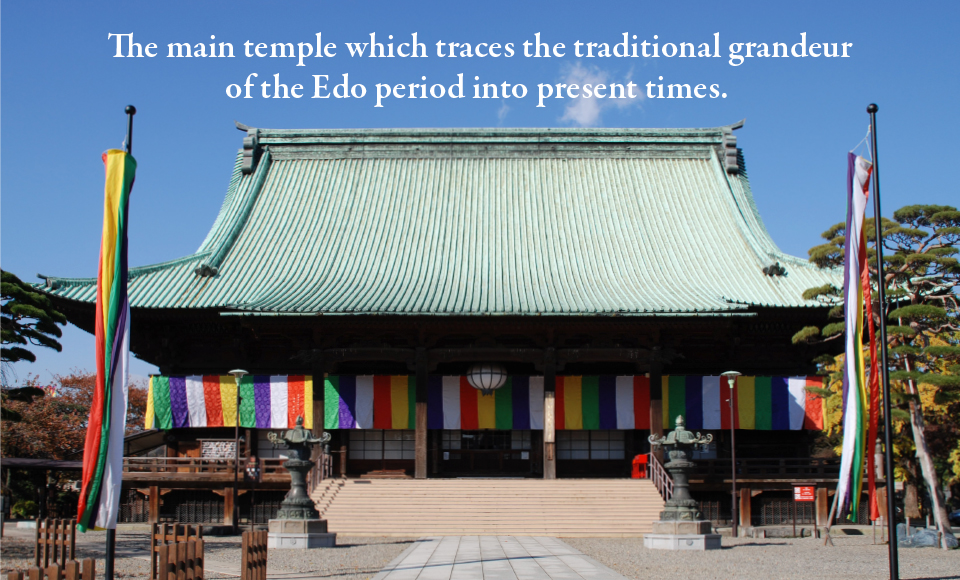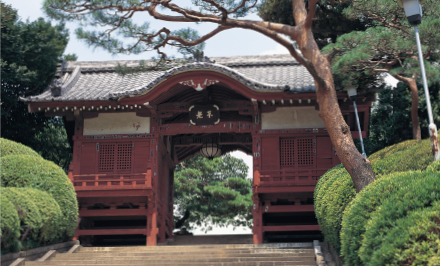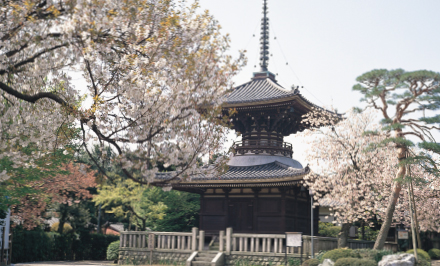

The main temple which traces
the traditional grandeur
of the Edo period into present times.
This temple was built in February 1681. The fifth shōgun, Tunayoshi Tokugawa, invited priest Ryōken of Daishō gokokuji temple, upon the request of his mother, Keishōin. This temple became sacred to the natural amber Nyoirin-Kanzeon-Zō. The present Kannon-Dō was built within half a year after the shogunate ordered it be built in January 1697. In August of the same year, the ceremony of opening was held. The main building is a large hall which was established to exhibit a collection of arts dating back to the Genroku period and is said to be the most magnificent in Tokyo. What’s more, in spite of an earthquake and a war, it was left unchanged. Its design traces the traditional grandeur of the Edo period into present times.
NIŌ-MON

Gokokuji temple which was worshiped by the Tokugawa Shōgun consists of the Kannon-Dō, Yakushi-Dō, Daishi-Dō built in Genroku period. Niō-Mon refers to the entrance to these.
We consider that it was built at a later period than the Kannon-Dō in 1697.
GEKKŌ-DEN

In 1928, A Guest house of the Nikkō-in of Mii temple was moved to its present place. It is the building of Momoyama period, which tells us the style of the shoin.
FURŌ-MON

It was built in April 1938. It was donated by Mr. Kunizo Mio. It was based on the gate of the Kurama temple in Kyoto and is located between Niō gate and the main building.“Furō” was written by letatsu Tokugawa himself.
DAISHI-DŌ

It is believed that the old Yakushi-Dō which was rebuilt in 1701 underwent drastic renovation from 1926 onward and then was moved to its present place. It upholds the traditions of Shingonshū’s Garan and the medieval period.
TAHŌ-TŌ

It was constructed in April 1938. This tower resembled the Tahōtō in the Ishiyama-temple. Mr. Keiichiro Ōgi designed this tower. It has the Dainichi Nyorai which was given by Mrs. Yoshiko Dan. Mr.Eisaku Hasegawa sculpted it. Mr. Tanaka designed patterns named Kin-Gin on the walk of the temple.
SŌ-MON

This leads to the Hondō. Its style is not of shrines and temples but of mansions of the daimyo’s. As the gate was dedicated to the fifth Shōgun Tsunayoshi Tokugawa and Keishōin, they were the only persons permitted to walk through them.
YAKUSHI-DŌ

It was built in 1691. Sutra-Dō was moved to its present place, and used as a Yakushi-Dō. Its feature is to use the way of Zenshū.
CHŪREI-DŌ

It was built in the fall of the 35th year of Meiji. Soldiers who died in the Nisshin War of Meiji 27 to 28 were buried here. It was built as a hall of worship.
SHŌRŌ-DŌ

Shōrō-Dō is particular about formalities and traditions among belfries. It is a belfry built of Irimoya-Style and was constructed in the middle of Edo period. In Tokyo Irimoya-Style is a cultural treasure as it is unique to Japan. Bonshō was presented in 1682. Its epitaph, explains how and why the Kannon-Dō was built. The bakufu warmly protected the Gokokuji-temple.
KEISHŌ-DEN & NAIBUTSU-DEN

In July of 1988, a new Hondō of modern architectural design and facilities was completed by Kajima construction company.





